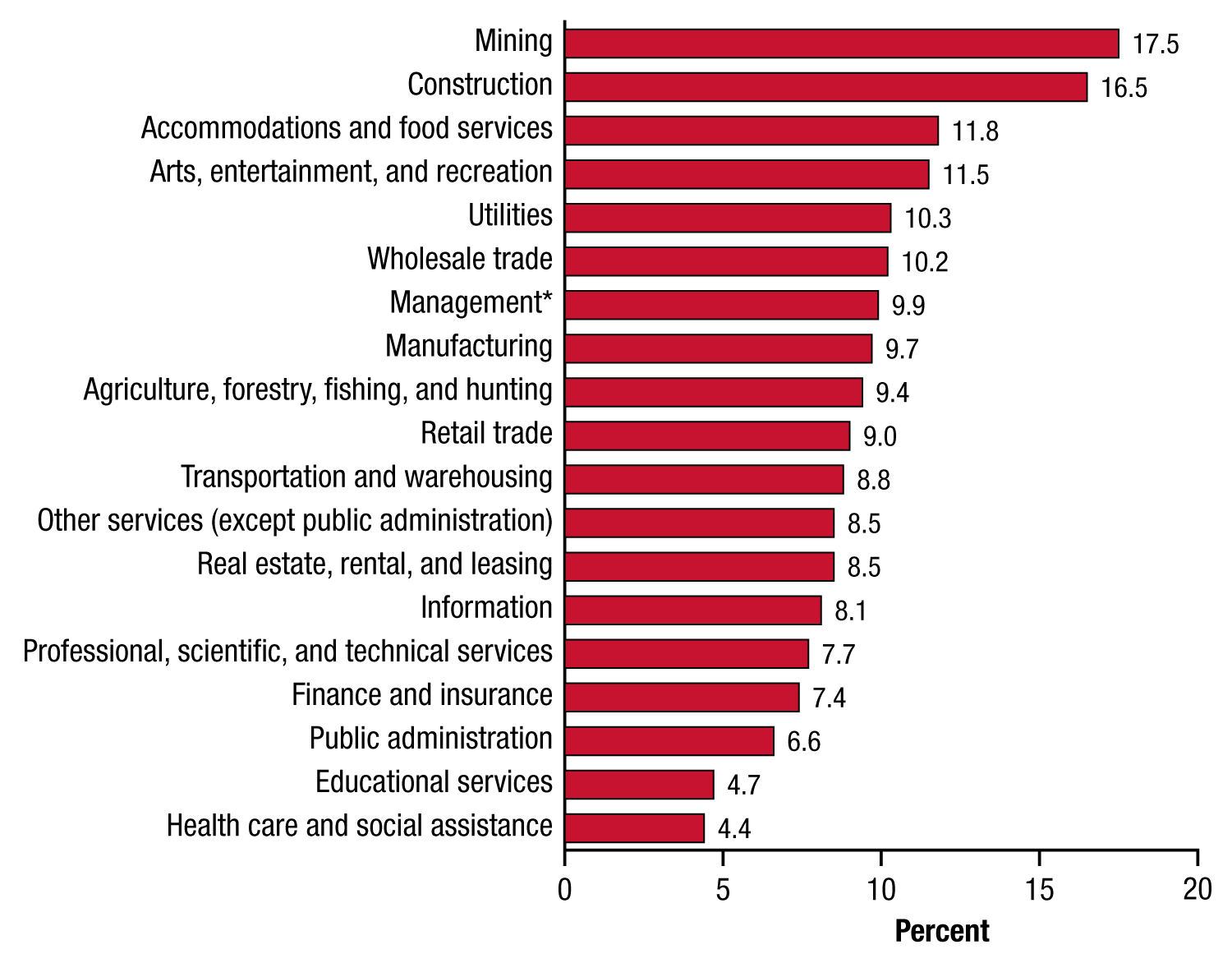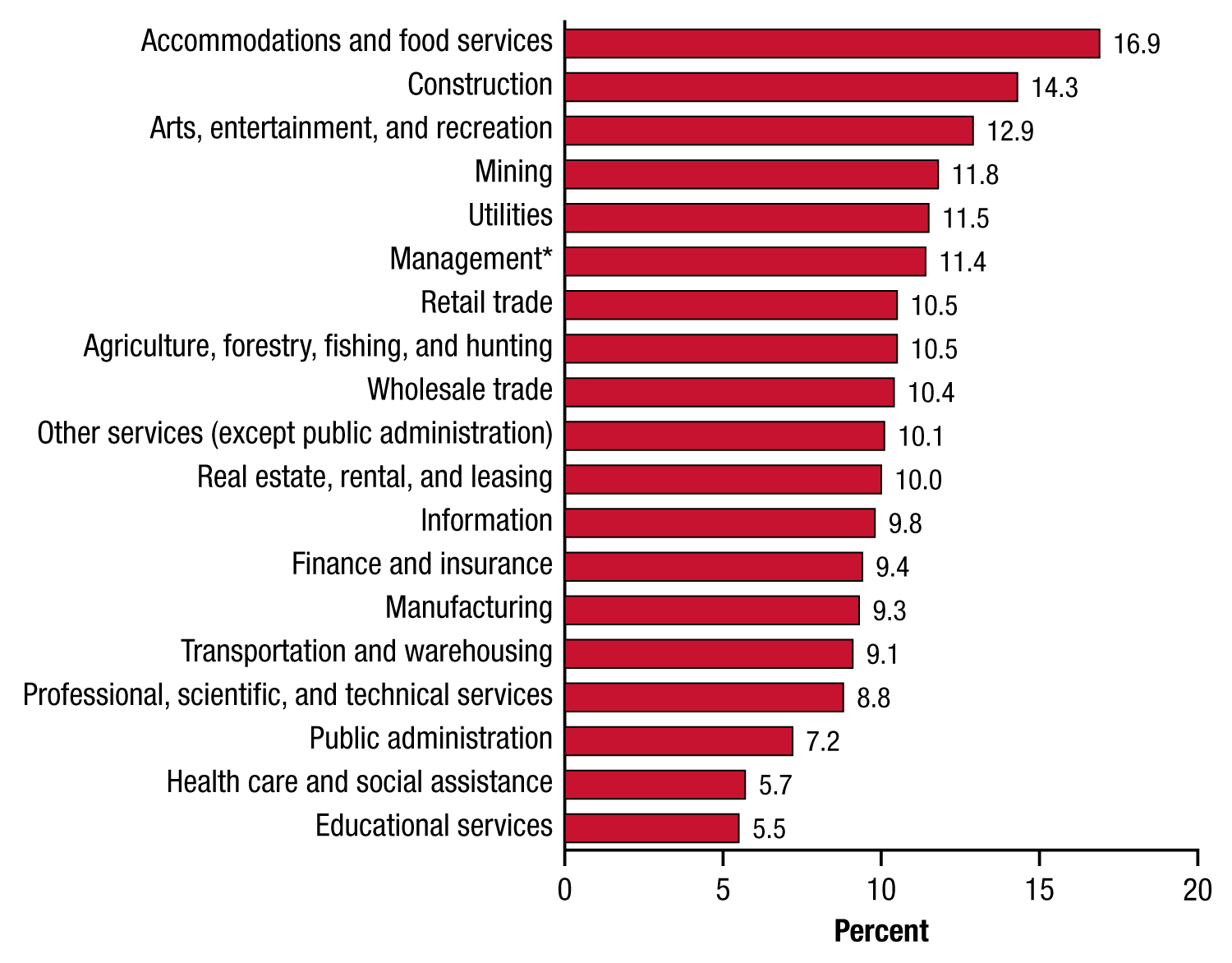One’s career can be a large determining factor when it comes to the development of a substance use disorder (or SUD). High stress, long working hours, and a demanding field can all drive someone to drink or consume drugs as a means of coping. Unfortunately, two of the most heavily afflicted career fields when it comes to substance addiction are the construction and mining industries. The workforce for these industries typically comes from a low education and household income background, and both fields involve strenuous physical labor, long hours, and unsafe working conditions.
According to the Substance Abuse and Mental Health Services Administration, both mining and construction experience some of the highest rates of substance abuse of any industry within the United States, skewing well above the average. This statistic is particularly disconcerting when you consider the relative dangers involved in both construction and mining as well as the necessity of our laborers to create infrastructure that meets safety standards.
Past Month Heavy Alcohol Use from 2008 to 2012

Meets the Qualifications for Substance Use Disorder (SUD) from 2008 to 2012

The data shows that alcohol usage and overall rates of substance use disorders are higher in the construction and mining industries than most others. Similarly afflicted fields of work are food services and the arts, entertainment, and recreational fields. For construction workers, the statistics are certainly outside the average.
- 16.5% of construction workers report heavy alcohol use within the past month, compared to a 9.5% average for the workforce in general, nearly twice as much.
- 11.6% of construction workers report illicit drug use in the past month, compared to an 8.8% average for the workforce in general.
- 14.3% of construction workers meet the criteria for a substance use disorder, compared to a 10% average for the workforce in general.
Substance Abuse While on the Job
The construction industry involves potentially more hazards for workers than any other occupation in the United States. The use of intoxicating substances while engaged in this type of work could significantly increase the likelihood of workplace injuries or even fatalities. Today, the construction industry is among the highest in the United States when it comes to workplace injuries. Increased monitoring and strict drug testing could help minimize this problem and create safer working conditions for everyone involved.
Another component to consider is the Occupational Safety and Health Act (OSHA) that requires all employers to provide ‘a place of employment which is free from recognized hazards that are causing or likely to cause death or serious physical harm.’ Any workplace in which employees are actively impaired by intoxicating substances, especially construction, would certainly be in violation of this law. As such, it would be highly beneficial for employers to make sure that their workforce is drug tested, as they would not want to face the fines or possible lawsuits for noncompliance. Policies like drug testing, access to inpatient and outpatient treatment services, and non-punitive disclosure requirements about illegal narcotic use could help the industry in numerous ways, such as:
- Reduce damage to company property
- Reduce workplace injuries and fatalities
- Recoup lost productivity
- Achieve regulatory compliance
Should the Construction Industry Drug Test?
Most employers in the United States do not require drug testing for employment. However, companies that do implement drug tests have seen drastic workplace improvements, including a 51% reduction in workplace injuries and a 12% reduction in compensation claims. Early detection is one of the most important elements of loss prevention, so construction companies would do well to implement highly vigilant, highly effective drug testing in order to determine whether employees may be impaired on the job site or not.
In addition, it must be acknowledged that substance abuse can take place through legal means as well. Prescription medication and alcohol use are just as if not more so dangerous than illicit narcotic usage. Although the industry has changed much in the last several years, the workplace culture of the construction industry generally condones the consumption of alcohol and society in general is more willing to take highly potent painkillers when prescribed by a doctor. The damage wrought by these legal substances is significant and workplaces must take serious precautions to ensure that employees are not impaired while on the clock.
Prevention and Safety for the Construction Industry
Substance abuse prevention programs should play a part in all workplace safety programs. The construction industry has made progress in this area through the efforts of the American National Standards Institute Construction and Demolition Standards Committee, which incorporated substance abuse prevention programs into their Key Elements of Safety and Health Programs. While this is an important step in the right direction, there is still a ways to go for the U.S. workforce in total. According to the National Council on Alcoholism and Drug Dependence, Roughly 70% of substance abusers report that they are actively employed.
The best way to solve this issue is by incorporating better drug screening, increase access to treatment, and encourage open lines of communication for employees who may need help. A multi-pronged approach can help more people achieve sobriety, helping their own long term happiness and increasing the productivity of the company they work for. The construction industry has been hard-hit by the disease of addiction, but through proper intervention, trust, and treatment, can reap the benefits of a sober workforce.
Drug and Alcohol Rehabilitation for Construction Workers
Inpatient Rehab, also known as Residential Treatment, can be beneficial for workers in the construction industry to recover from substance dependency. Inpatient care takes place at a facility and typically involves stays of anywhere from 30 – 90 days depending on the facility. While enrolled in inpatient rehab, a resident may first undergo medically supervised detoxification.
During detox, the patient will completely withdraw from their substance, often times through the use of supplemental medications that ease withdrawal symptoms, such as Suboxone, Vivitrol, and Methadone. This process typically lasts 7-10 days. The rest of a patient’s stay in a residential treatment center is centered around teaching the patient skills related to continued sobriety, therapy sessions designed to explore the underlying triggers of substance abuse, and support groups designed to help recovering addicts share their story in a safe, private environment.
One of the major benefits of this kind of treatment is that the person is removed from their living environment. Though not always the case, their environment may likely be an underlying cause for triggering their substance use. It helps to break free from this and begin in a fresh environment that allows one to examine their life from a distance. By remaining in a treatment facility, the patient is able to fully focus on their recovery.
Intensive Outpatient Rehab
Intensive Outpatient Rehab (known as IOP or Intensive Outpatient Program) is designed for people with substance abuse problems as well as dual diagnoses with co-occurring mental and substance abuse disorders. IOP’s are an alternative to inpatient rehab that can accommodate your busy work schedule. Whereas with inpatient you will be in a medically supervised environment for 1 to 3 months, IOP allows you the freedom to come and go. IOP contains many of the same services however, such as therapy, relapse management, and coping strategies.
Research has shown intensive outpatient rehab to be as successful as other forms of treatment available. IOP typically ranges from 9 or more hours per week of sessions in a facility, allowing the patient to live at home and carry on with their day to day activities. IOP is sometimes preferred in less severe cases of addiction because it allows the patient to continue working, take care of any dependents, and hopefully become more well adjusted to sober life in their community. Although IOP may not be the perfect solution for every candidate, it is great for those deemed to be qualified.
Government Protection for Your Job During Rehab
The United States federal government has specific protections in place that make it so anyone who enters a treatment facility for drug or alcohol addiction is automatically protected against job loss, including workers in the construction industry. The main act that protects you is the Family and Medical Leave Act (FMLA).
Family and Medical Leave Act (FMLA)
The FMLA sets requirements for employers to allow you to take sick leave. Since addiction is a disease, employers must treat it the same way as any other illness. All businesses, federal agencies, and government agencies must provide 12 weeks of unpaid sick leave for their employees. However, there are some requirements that must be met first.
“Your company must allow you to have up to 12 weeks of paid leave for addiction treatment.” – FMLA
This is great news for anyone suffering from addiction while employed, however, there are some requirements that must be met first. While you cannot be fired or unpaid for addiction treatment while employed, you and your company must meet the following requirements:
- You must have been employed with the company for at least 12 months.
- You must have worked at least 1,250 hours during the 12 months prior to the start of FMLA leave.
- Your company must employ 50 or more employees within a 75-mile radius of the work site.
While you can’t be fired, the FMLA does not guarantee you will be paid during this time. One way to help supplement your income during this time is to apply for short-term disability. Short-term disability will guarantee you at least a portion of your pay while you are in treatment. In order to claim these protections, you will need apply for it.
In Conclusion
The stigma and fears associated with entering rehab can be enough for many people to refrain from seeking treatment from a drug and alcohol rehabilitation center. According to SAMHSA, only 10% of the people who need treatment for drug and alcohol addiction actually receive it. If you would like more information about addiction counseling, resources, and information about drug treatment/alcohol treatment, visit the Landmark Recovery blog today!

Choose Recovery Over Addiction
We're here 24/7 to help you get the care you need to live life on your terms, without drugs or alcohol. Talk to our recovery specialists today and learn about our integrated treatment programs.



